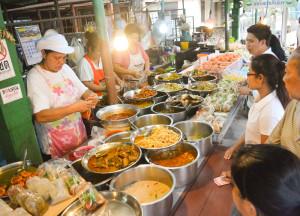 No matter where you go, traveling is an adventure. It opens you up to try new things you may never have considered doing back home, including trying all types of new, exotic, and downright weird foods.
No matter where you go, traveling is an adventure. It opens you up to try new things you may never have considered doing back home, including trying all types of new, exotic, and downright weird foods.
While you should toss some caution to the wind and try new things when you’re abroad, you should also keep in the back of your mind there’s a possibility food hasn’t been prepared to the best standards And, let’s be honest, food poisoning isn’t fun, especially when traveling.
Here’s what you can do to still eat those exotic foods without the risk of getting sick.
Train your stomach before traveling
If you eat simple meals of meat and vegetables day in and day out, your stomach is not at all prepared for exotic cuisine during your trip. And, for the record, Pad Thai and kimchee aren’t all that exotic. Some dishes abroad can consist of up to 20 ingredients – if your body isn’t used to a large number of complex flavors and spices, it will let you know pretty quickly.
Before you leave, seek out new types of foods and recipes to train your stomach to the variety.
Make sure your hands and cutlery are clean
It’s always important to wash your hands before eating, or at least lather up with hand sanitizer. This is even more important when you’re traveling abroad – you’re going to be touching a lot of things like door knobs, handrails, benches and, worse, money.
Before chowing down, make sure you thoroughly wash away those germs with soap and water. Pack a bottle of hand sanitizer in your purse or bag just in case you stop to eat somewhere and don’t have access to soap and running water. This is especially important if you’re eating with your hands instead of utensils, which is quite possible in many countries.
With the mindset of “better safe than sorry,” consider bringing antibacterial wet wipes with you to give utensils a wipe down in case they weren’t thoroughly washed.
Pick busy restaurants
While a long wait at a restaurant doesn’t seem ideal when you’re already hungry, when it comes to eating in a new place, long lines are a good sign. A crowd at a restaurant means a couple things: The food is good and it’s not making people sick. Long lines and high turnover also means food likely isn’t sitting out and spoiling.
Don’t be afraid to do a little snooping – make sure prep stations look clean, raw foods are stored separately, and cold foods are on ice.
If you’re strapped for time or all of the restaurants seem quiet, choose the restaurant with the fewest items on the menu. A small menu indicates they focus on the quality and flavor of a few items, with less of a chance of using ingredients left over from the previous day.
Choose places where you can see them cook
Many international cities are known for their exotic street food. While you may initially be wary of this dining option, it gives you the opportunity to see how they’re preparing their food. You can see if they’re taking short cuts, how the food is being stored before it’s cooked, and whether the person cooking is also handling money.
In general, when it comes to street vendors, opt for hot options – and make sure the food is piping hot when you’re served.
Some other things you can do to avoid getting sick include:
- Wash fruit and vegetables with bottled water
- Get recommendations for restaurants from people who’ve eaten there before
- Get a prescription for an antibiotic before you leave the U.S. in case of severe food poisoning
- Skip ice cubes and limit yourself to bottled water with the seal intact
What do you do to avoid upsetting your stomach while on vacation?
Photo from Tropical Medical Bureau.


